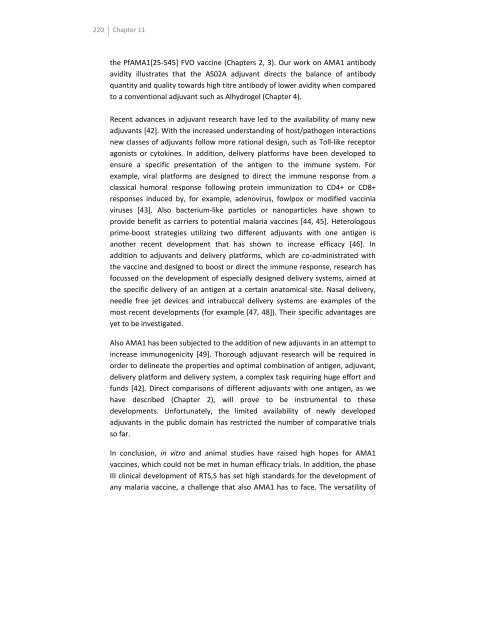Experimental infection and protection against ... - TI Pharma
Experimental infection and protection against ... - TI Pharma
Experimental infection and protection against ... - TI Pharma
You also want an ePaper? Increase the reach of your titles
YUMPU automatically turns print PDFs into web optimized ePapers that Google loves.
220 Chapter 11<br />
the PfAMA1[25-545] FVO vaccine (Chapters 2, 3). Our work on AMA1 antibody<br />
avidity illustrates that the AS02A adjuvant directs the balance of antibody<br />
quantity <strong>and</strong> quality towards high titre antibody of lower avidity when compared<br />
to a conventional adjuvant such as Alhydrogel (Chapter 4).<br />
Recent advances in adjuvant research have led to the availability of many new<br />
adjuvants [42]. With the increased underst<strong>and</strong>ing of host/pathogen interactions<br />
new classes of adjuvants follow more rational design, such as Toll-like receptor<br />
agonists or cytokines. In addition, delivery platforms have been developed to<br />
ensure a specific presentation of the antigen to the immune system. For<br />
example, viral platforms are designed to direct the immune response from a<br />
classical humoral response following protein immunization to CD4+ or CD8+<br />
responses induced by, for example, adenovirus, fowlpox or modified vaccinia<br />
viruses [43]. Also bacterium-like particles or nanoparticles have shown to<br />
provide benefit as carriers to potential malaria vaccines [44, 45]. Heterologous<br />
prime-boost strategies utilizing two different adjuvants with one antigen is<br />
another recent development that has shown to increase efficacy [46]. In<br />
addition to adjuvants <strong>and</strong> delivery platforms, which are co-administrated with<br />
the vaccine <strong>and</strong> designed to boost or direct the immune response, research has<br />
focussed on the development of especially designed delivery systems, aimed at<br />
the specific delivery of an antigen at a certain anatomical site. Nasal delivery,<br />
needle free jet devices <strong>and</strong> intrabuccal delivery systems are examples of the<br />
most recent developments (for example [47, 48]). Their specific advantages are<br />
yet to be investigated.<br />
Also AMA1 has been subjected to the addition of new adjuvants in an attempt to<br />
increase immunogenicity [49]. Thorough adjuvant research will be required in<br />
order to delineate the properties <strong>and</strong> optimal combination of antigen, adjuvant,<br />
delivery platform <strong>and</strong> delivery system, a complex task requiring huge effort <strong>and</strong><br />
funds [42]. Direct comparisons of different adjuvants with one antigen, as we<br />
have described (Chapter 2), will prove to be instrumental to these<br />
developments. Unfortunately, the limited availability of newly developed<br />
adjuvants in the public domain has restricted the number of comparative trials<br />
so far.<br />
In conclusion, in vitro <strong>and</strong> animal studies have raised high hopes for AMA1<br />
vaccines, which could not be met in human efficacy trials. In addition, the phase<br />
III clinical development of RTS,S has set high st<strong>and</strong>ards for the development of<br />
any malaria vaccine, a challenge that also AMA1 has to face. The versatility of













